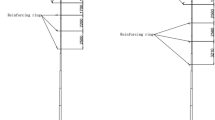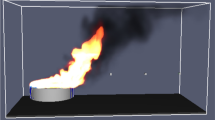Abstract
Storage tanks are placed in group arrangements in refinery plants. Furthermore, winds may be treated as a critical lateral load for such structures. The present study explores the effects of storage tank adjacency on wind pressure variations. The wind tunnel test was employed to obtain the wind pressure coefficients on corrugated-plate tanks with rise-to-span ratios of 0.25, 0.5, 1.0, and 1.5. These coefficients were also calculated numerically through a computational fluid dynamics (CFD) approach and compared to the experimental data. To evaluate the adjacency effect, two adjacent tanks in the transverse and longitudinal directions and the base tank with longitudinal and transverse adjacency were studied. The wind pressure coefficients were compared to the non-adjacency scenario. It was found that the adjacency effect was below 10% in transverse and longitudinal adjacency scenarios at distances three and four times as large as the diameter, respectively. The corrugated-plate tanks were found to have smaller negative (suction) pressure coefficients than simple-plate ones.


















Similar content being viewed by others
References
Yang Q, Gao R, Bai F, Li T, Tamura Y (2018) Damage to buildings and structures due to recent devastating wind hazards in East Asia. Nat Hazards 92:1321–1353
Katsumura A, Tamura Y, Nakamura O (2007) Universal wind load distribution simultaneously reproducing largest load effects in all subject members on large-span cantilevered roof. J Wind Eng Ind Aerodyn 95:1145–1165
Taylor TJ (1992) Wind pressures on a hemispherical dome. J Wind Eng Ind Aerodyn 40:199–213
Zasso A, Giappino S, Muggiasca S (2006) Wind tunnel study of a cone-like shaped roof: Reynolds number effects. J Wind Eng Ind Aerodyn 94:431–444
Kim YC, Yoon SW, Cheon DJ, Song JY (2019) Characteristics of wind pressures on retractable dome roofs and external peak pressure coefficients for cladding design. J Wind Eng Ind Aerodyn 188:294–307
Sadeghi H, Heristchian M, Aziminejad A, Nooshin H (2018) CFD simulation of hemispherical domes: structural flexibility and interference factors. Asian J Civil Eng 19:535–551
Uematsu Y, Tsuruishi R (2008) Wind load evaluation system for the design of roof cladding of spherical domes. J Wind Eng Ind Aerodyn 96:2054–2066
Ebrahim R, Hossein S, Reza HM (2022) Wind effect on building with Y-shaped plan. Asian J Civil Eng 23:141–151
Cheng CM, Fu CL (2010) Characteristic of wind loads on a hemispherical dome in smooth flow and turbulent boundary layer flow. J Wind Eng Ind Aerodyn 98:328–344
Sadeghi H, Heristchian M, Aziminejad A, Nooshin H (2017) Wind effect on grooved and scallop domes. Eng Struct 148:436–450
Hu G, Kwok KCS (2020) Predicting wind pressures around circular cylinders using machine learning techniques. J Wind Eng Ind Aerodyn 198:104099
Liu M, Li QS, Huang SH (2019) Large eddy simulation of wind-driven rain effects on a large span retractable roof stadium. J Wind Eng Ind Aerodyn 195:104009
Sun Y, Qiu Ye, Yue Wu (2013) Modeling of Wind Pressure Spectra on Spherical Domes. Int J Space Struct 28:87–100
Chen Z, Huaqiang Li Xu, Wang XY, Xie Z (2019) Internal and external pressure and its non-Gaussian characteristics of long-span thin-walled domes. Thin-Walled Struct 134:428–441
Li T, Yan G, Feng R, Mao X (2020) Investigation of the flow structure of single- and dual-celled tornadoes and their wind effects on a dome structure. Eng Struct 209:109999
Su N, Peng S, Uematsu Y (2021) Reynolds number effects on the wind pressure distribution on spherical storage tanks. J Wind Eng Ind Aerodyn 208:104464
Shokrzadeh AR, Sohrabi MR (2016) Strengthening effect of spiral stairway on the buckling behavior metal tanks under wind and vacuum pressures. Thin-Walled Struct 106:437–447
Sanyal P, Dalui SK (2021) Effects of side ratio for ‘Y’plan shaped tall building under wind load. Build Simul 14:1221–1236
Qiu Y, Sun Y, Wu Y, Tamura Y (2014) Modeling the mean wind loads on cylindrical roofs with consideration of the Reynolds number effect in uniform flow with low turbulence. J Wind Eng Ind Aerodyn 129:11–21
ANSYS I (2016) CFD Programmer’s guide (Release 17.2). ANSYS Inc., Canonsburg
Bardina JE, Huang PG, Coakley TJ (1997) Turbulence modeling validation, testing, and development (No. A-976276)
Jones WP, Launder BE (1972) The prediction of laminarization with a two-equation model of turbulence. Int J Heat Mass Transf 15:301–314
Launder BE, Sharma BI (1974) Application of the energy-dissipation model of turbulence to the calculation of flow near a spinning disc. Lett Heat Mass Tran 1:131–137
Author information
Authors and Affiliations
Corresponding authors
Ethics declarations
Conflict of Interest
All authors certify that they have no affiliations with or involvement in any organization or entity with any financial interest or non-financial interest in the subject matter or materials discussed in this manuscript.
Additional information
Publisher's Note
Springer Nature remains neutral with regard to jurisdictional claims in published maps and institutional affiliations.
Rights and permissions
Springer Nature or its licensor (e.g. a society or other partner) holds exclusive rights to this article under a publishing agreement with the author(s) or other rightsholder(s); author self-archiving of the accepted manuscript version of this article is solely governed by the terms of such publishing agreement and applicable law.
About this article
Cite this article
Davarzani, H.R., Ganjali, A., Sadeghi, H. et al. Numerical and Experimental Study of Wind Effect on the Storage Tanks Based the Tank Adjacency. Exp Tech 48, 191–204 (2024). https://doi.org/10.1007/s40799-023-00653-1
Received:
Accepted:
Published:
Issue Date:
DOI: https://doi.org/10.1007/s40799-023-00653-1




